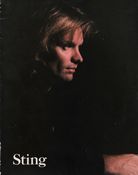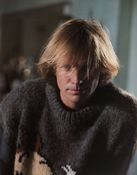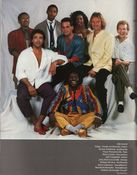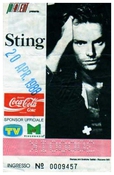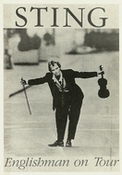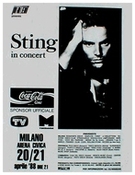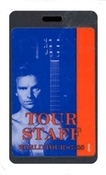
Sting, the Narcissus of Rock - But where has the old energy gone?
The Italian debut at the Arena Civica in Milan. The first part of the concert featured all the songs from 'Nothing Like the Sun,' followed by the other songs, including those written with the Police. A few ominous shadows loomed on the horizon: first complacency, then the tendency to make his music as glossy as fashion products.
Finally, after much talk, Sting stepped onto a stage, officially launching the incandescent rock season that awaits us. Blond, dressed in white, against the still-bright sky, he seemed the perfect embodiment of the sunny, transparent, almost angelic myth that his music today embodies. He moved little, at least in the first part of the concert, adding an ascetic, purifying touch to a silhouette that already seemed all too reminiscent of sanctity. And even the opening scene leaves no doubt: "The Lazarus Heart" with its insistent refrain of "every day another miracle," which, placed at the beginning of the show, surely also alludes to the miracle of live music, which every night brings to life and dies a long story to be told, always the same yet always different.
But this time the miracle was only half accomplished. The entire first part of the concert, structured almost exclusively around songs from the latest album, offers a necessary comparison with the repertoire and atmosphere of that unrepeatable gem that was the previous tour, with all the unbridled desire, enthusiasm, and anger of an artist who, for the first time, was breaking out of the protective shell of the group to venture out as a solo artist. Today, there's the Gershwin-esque style of "Englishman in New York," the faded repetition of "We'll Be Together" that dimly recalls the originality of "Set Them Free," the superfluity of songs like "Rock Steady" and "Straight to My Heart."
To rediscover true energy, we have to wait for the Police reference of "Too Much Information," or the twilight and tenuous inspiration of "Sister Moon," one of the few truly moving songs on this new album, "Nothing Like the Sun," which preceded Sting's generous live tour of the world. These songs feel like a precious liquid unexpectedly diluted with water. The strength, if any, is lost in a colourless mixture, dosed gently so as not to overwhelm the audience.
A few ominous shadows loom over the Sting phenomenon: complacency, primarily due to excessive narcissism, and, in some ways, a tendency to desexualize his music, making it slippery and glossy like today's fashion products. And there's no need to miss the blistering, dark, and lunar energy of The Police; no need to miss that three-way interlocking that, as it appears today, forced Sting into healthy group work. It's enough to miss his early solo adventures, the dream of the Blue Turtles; so compact, essential, searing. Back then, supporting the dream were Omar Hakim and Darryl Jones, drums and bass reminiscent of the most restless and uncompromising technological tribalism; today, there are Jean Paul Ceccarelli and Tracy Wormworth, a bassist who, instead of whipping the group forward, drives the collective rhythm.
But fortunately, the concert is governed by the ancient and ever-effective law of crescendo. As night falls, and after the required list of new songs has been completed, Sting and his band, aided by the darkness, go to recapture shreds of energy and even lost time: "One World," "Set Them Free," and finally a beautiful, rousing version of "Bring on the Night," a song that belongs to the pinnacle of The Police's history, but which was reinterpreted and perhaps even improved upon by Sting as a soloist.
And the crescendo continues in the second half, opening with the exemplary "They Dance Alone," a masterpiece of balance between poetic emotion and political sensitivity, and then building towards "King of Pain," "Walking in Your Footsteps," "Little Wing," and "Fortress Around Your Heart," with the exception of "Russians," which today, like two years ago, continues to strike us as a heavy downfall of indifferentism.
With his uncategorized music and star-like charm, Sting is a quintessential figure in contemporary music, or at least represents the pressing need for individualism within rock. Let's not forget that perhaps rock's most revolutionary contribution to contemporary culture was precisely the idea of an art developed by a group, that is, by a collective performance. Today, this is much less common; the leading figures are almost all soloists, and this must be interpreted in connection with the different tensions and behavioural models in force. This is how we should understand Sting's story, the transition from group work to individual work, and it wouldn't be negative in itself if it didn't present risks that every artist should consider. If you can no longer see yourself reflected in your peers, you risk ending up mirrored in your own image.
Shadows, risks still distant, but not completely absent from who Sting is today. Even though everyone, at the end of the concert, was willing to forget it, as always after re-listening to the masterpieces of the past: "Don't Stand So Close To Me" and especially "Message in a Bottle," interspersed with a precious tribute to the Italian audience: the romance "Caro mio ben," from Handel's Serse, in memory of Caruso, sung like an elegant whisper in perfect Italian. The farewell, as always, was the message in the bottle, to be entrusted to the sea. It was the meaning of a generation of castaways still searching for utopia: I woke up this morning and couldn't believe what I saw: millions of bottles on the beach.
But does it still make sense today? For the bottles to return, in an avalanche, the message must be precise, addressed to the ears of all those who still want to hear the right words.
(c) La Repubblica by Gino Castaldo (thanks to Valeria Vanella)

